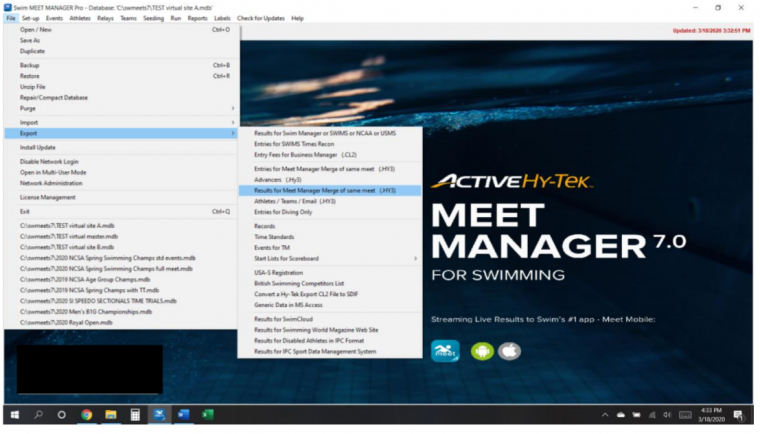

The organization actually set the stage for this back in April when itissued a four-page document containing guidelines for conducting virtual meets, which allowed teams to compete at their own pools with officials present and then submit their times to be compared against the timed finishes of other teams.
“While created to address short-term concerns caused by the global pandemic, the virtual competition tool is a long-term investment for the sport that can help bridge the gap between summer league competitors and premium year-round members, and introduce competition to beginner-level club swimmers,” USA Swimming officials said in a statement at the time.
Indeed, virtual swim meets have helped sustain the sport during the coronavirus pandemic. Although it’s easier to social distance in swimming than in other sports, the risks of packing so many athletes onto a crowded deck in a humid indoor environment are just to great to host traditional meets. Plus, many states still prevent gatherings of more than 50 people.
In August, one of the summer’s largest virtual swim events in the United States took place with hundreds of swimmers on 16 teams from six states. The format, according to SwimSwam.com, featured a series of meets starting with a round of 16, followed by quarterfinals, semifinals and a championship showdown. Times were tracked by the Swimmingly swim meet timing app.
“What an amazing experience for our swimmers to get back into racing,” reads a collective statement from the coaches of Team Eugene Aquatics from Eugene, Ore., winners of the meet by a mere five points. “We all had a blast cheering and racing and were thrilled to see some fast times. … To go through such a long period of no water, and then come out of it with a championship like this speaks to how resilient these kids are.”
Some but certainly not all high school swim teams recently returned to the pool for the fall season. But the stands are empty, relays are eliminated and, in some cases, state meets already are canceled.
“It doesn’t make safety sense at this time for our swimmers to travel if they don’t have to,” Christine Harding, coach of the girls’ swimming and diving team at Torrington (Conn.) High School, told the Republican-Americani n Waterbury, Conn. “Competitive swimming is against the clock, and that is what really counts. My athletes are excited to get in the water and are well aware of the unique situation in front of them, and they are willing to do whatever is necessary to keep everyone safe.”
Indeed, participating in virtual meets certainly takes some getting used to. Alex Goldin, a freestyle sprinter at Highland Park (Ill.) High School, admitted that to the Pioneer Press, publisher of several local newspapers in the Chicago area. “I knew it would be hard to get motivated,” Goldin, a junior, said. “You go to competition to race [other teams], whereas practice is racing against yourself and your teammates. The whole point of competition is to see those girls in the lane next to you.Now, it’s about how well you’re able to transfer yourself into a state of competitiveness. It’s hard.”
Some schools in states like Arizona, where outdoor competitions are common, have opted to host dual meets at the same pool.
“We had the visiting team and our team sit on two different large sections of bleachers that had X’s spaced out over six feet apart,” said Pat O’Neill, coach of the Red Mountain High School boys’ swim team in Mesa, Ariz., told the Arizona Republic after Red Mountain hosted Mesa’s Desert Ridge High School at the city’s outdoor Skyline Aquatic Center in mid-September. “We coordinated with the visiting team about procedures, and masks were being worn at all times, except walking to and from your race, and of course during the race.
“We would run one race and then clear those swimmers around the east end before the next heat approached the blocks from the west end,” O’Neill added. “The pace of the meet was a lot slower due to only allowing one heat behind the blocks at a time.”
One spectator per athlete was allowed to sit in the stands — socially distanced, of course.
Swimming isn’t the only sport that’s gone virtual. Cross country meets also are gaining popularity this fall.
“This is the sport to be in this year, for sure,” Debby Eddy, assistant coach of the Petersburg (Alaska) High School cross country teams, told local media after Petersburg competed virtually against several other schools in southeastern Alaska. All teams timed their own 5K races and then shared them. Coaches at the participating schools agreed on a formula to use to determine scores, and variables included such data as a runner’s times from previous years.
“No system is perfect, but in this sense it was better than nothing,” Eddy said. “So, it was a great opportunity for the kids to see kind of where they lined up with [other runners] so far.”
Virtual marathons, cycling events and track meets also are gaining popularity, as sports event organizers and participants adjust to a changing sports landscape.

